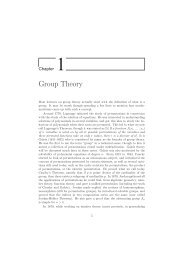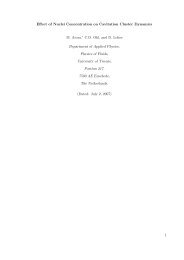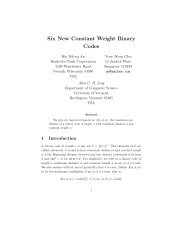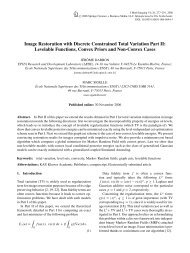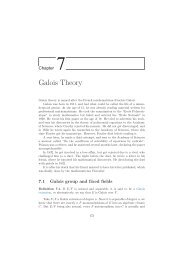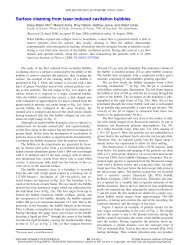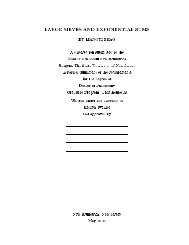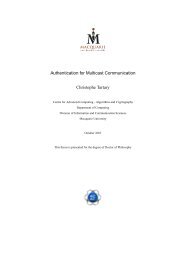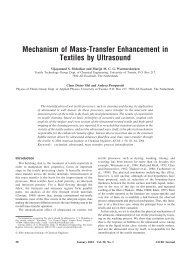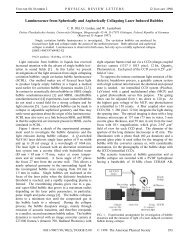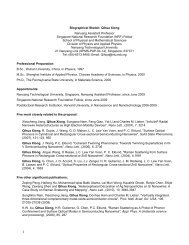Field Theory
Field Theory
Field Theory
You also want an ePaper? Increase the reach of your titles
YUMPU automatically turns print PDFs into web optimized ePapers that Google loves.
Chapter 5<strong>Field</strong> <strong>Theory</strong>Abstract field theory emerged from three theories, which we would now callGalois theory, algebraic number theory and algebraic geometry.<strong>Field</strong> theoretic notions appeared, even though still implicitly, in the moderntheory of solvability of polynomial equations, as introduced by Abel and Galoisin the early nineteenth century. Galois had a good insight into fields obtainedby adjoining roots of polynomials, and he proved what we call now the PrimitiveElement Theorem.Independently, Dedekind and Kronecker came up with the notion of algebraicnumber fields, arising from three major number -theoretic problems: Fermat’sLast Theorem, reciprocity laws and representation of integers by binaryquadratic forms.Algebraic geometry is the study of algebraic curves and their generalizationsto higher dimensions, namely, algebraic varieties. Dedekind and Weber carriedover to algebraic functions the ideas which Dedekind had earlier introduced foralgebraic numbers, that is, define an algebraic function field as a finite extensionof the field of rational functions.At the end of the nineteenth century, abstraction and axiomatics started totake place. Cantor (1883) defined the real numbers as equivalence classes ofCauchy sequences,von Dyck (1882) gave an abstract definition of group (aboutthirty years after Cayley had defined a finite group). Weber’s definition of afield appeared in 1893, for which he gave number fields and function fields asexamples. In1899, Henselinitiatedastudyofp-adicnumbers, takingasstartingpoint the analogy between function fields and number fields. It is the work ofSteinitz in 1910 that initiated the abstract study of fields as an independentsubject. A few examples of his results are: classification of fields into thoseof characteristic zero and those of characteristic p, development of the theoryof transcendental extensions, recognition that it is precisely the finite, normal,separable extensions to which Galois theory applies, proof of the existence ofthe algebraic closure of any field.147
148 CHAPTER 5. FIELD THEORYMajor developments in field theory and related areas that followed Steinitz’swork include valuation theory, class field theory, infinite Galois theory and finitefields.5.1 <strong>Field</strong> extension and minimal polynomialDefinition 5.1. If F and E are fields, and F ⊆ E, we say that E is an extensionof F, and we write either F ≤ E or E/F.Examples 5.1. Here are some classical examples:1. C = {a+bi, a,b ∈ R} is a field extension of R.2. Q( √ 2) = {a+b √ 2, a,b ∈ Q} is a field extension of Q.3. Q(i) = {a+bi, a,b ∈ Q} is a field extension of Q.If E is an extension of F, then in particular E is an abelian group underaddition, and we may multiply x ∈ E by λ ∈ F. We can see that this endows Ewith a structure of F-vector space (the elements of E are seen as vectors, thoseof F as scalars). It then makes sense to speak of the dimension of E over F.Definition 5.2. Let E/F be a field extension. The dimension of E as F-vectorspace is called the degree of the extension, written [E : F]. If [E : F] < ∞, wesay that E is a finite extension of F, or that the extension E/F is finite.Let us get back to our examples:Examples 5.2. 1. Consider the field extension C/R. We have that C is avector space of dimension 2 over R. It is thus an extension of degree 2(with basis {1,i}).2. The field extension Q( √ (2))/Q is of degree 2, it is called a quadraticextension of Q.3. The field extension Q(i)/Q is a also a quadratic field extension of Q.4. Both Q( √ (2))/Q and Q(i)/Q are finite field extensions of Q. Finite extensionsof Q are called number fields.If we look at C, we see it is obtained by adding i to R, and i is a root ofthe polynomial X 2 + 1. Similarly, Q( √ 2)/Q is obtained by adding a root ofthe polynomial X 2 − 2. In what follows, we will make formal the connectionbetween roots of polynomials and field extensions.Before we start, recall that if we have two fields E,F and a field homomorphismbetween them (that is, a ring homomorphism between two fields), thenf is a monomorphism. We have seen the argument in the previous chapteralready: the kernel of a ring homomorphism is an ideal, and a field has onlytrivial ideals, namely {0} and itself, and it cannot be that the whole field is thekernel.
5.1. FIELD EXTENSION AND MINIMAL POLYNOMIAL 149Theorem 5.1. Let f be a non-constant polynomial over a field F. Then thereis an extension E/F and an element α ∈ E such that f(α) = 0.Proof. Recall that F[X] is aunique factorization domain, thus f can be factoredinto a product of irreducible polynomials, and we may assume without loss ofgenerality that f is itself irreducible. Consider now the idealI = (f(X))in F[X], the ring of polynomials with indeterminate X and coefficients in F.Again using that F[X] is a unique factorization domain, we have that f(X) isirreducible and equivalently prime, implying that (f(X)) is prime. Now F[X] isfurthermore a principal ideal domain. This means that I = (f(X)) is containedin a principal maximal ideal (q(X)), so that q(X) divides the prime f(X). Sincef(X) = q(X)g(X) for some g(X), and q(X) cannot be a unit because f(X) isirreducible, f(X) and q(X) are associates, and (f(X)) = (q(X)), proving that(p(X)) = I is maximal. Thus by the characterization of maximal ideals withrespect to their quotient ring, we have thatE = F[X]/Iisafield. WenowplaceanisomorphiccopyofF insideE viathemonomorphismh : F → E, a ↦→ a+I.This thus gives a field extension E/F. Now letα = X +I ∈ E.We are left to prove that α is a root of f(X). If f(X) = a 0 +a 1 X+...+a n X n ,thenwhich is zero in E.f(α) = (a 0 +I)+a 1 (X +I)+...+a n (X +I) n= a 0 +I +a 1 X +a 1 I +...+a n X n +...+a n I n= (a 0 +a 1 X +...+a n X n )+I= f(X)+IThe extension E is sometimes said to be obtained from F by adjoining aroot of f.Remark. Note that in the above proof, we have shown that a prime ideal in aprincipal ideal domain is maximal.Definition 5.3. If E is an extension of F, an element α ∈ E is said to bealgebraic over F if there is a non-constant polynomial f ∈ F[X] such thatf(α) = 0. If α is not algebraic over F, it is said to be transcendental over F.If every element of E is algebraic over F, then E is said to be an algebraicextension of F.
150 CHAPTER 5. FIELD THEORYSuppose that α ∈ E is algebraic over F. Thus there exists by definition apolynomial f ∈ F[X] with f(α) = 0. It thus makes sense to consider the set Iof all polynomials g ∈ F[X] such that g(α) = 0. Clearly• if g 1 ,g 2 are in I, so does g 1 ±g 2 ,• if g ∈ I and h ∈ F[X], then gh ∈ I.This tells us that I = {g ∈ F[X], g(α) = 0} is an ideal of F[X].Since F[X] is a principal ideal domain, we haveI = (m(X))for some m(X) in F[X]. Any two generators of I are thus multiple of eachothers, so they must be of same degree, and since m(X) is monic, it has to beunique. This polynomial m(X) has the following properties:1. If g ∈ F[X], then g(α) = 0 if and only if m(X) divides g(X). This is clearfrom the definition of I.2. m(X) is the monic polynomial of least degree such that m(α) = 0, whichfollows from the above property.3. m(X) is the unique monic irreducible polynomial such that m(α) = 0.Indeed, if m(X) = h(X)k(X) with degh < degm, degk < degm, theneither h(α) = 0 or k(α) = 0, so that either h(X) or k(X) is a multiple ofm(X) by the first property, which is impossible. Thus m(X) is irreducible.We are left to prove the unicity of m(X). This comes from the fact thatsince m(X) is monic, then if there were two irreducible monic polynomialsm(X) and m ′ (X) such that m(α) = m ′ (α) = 0, they have α as commonroot, and thus m(X) and m ′ (X) cannot be distinct (see the propositionbelow).Definition 5.4. The polynomial m(X) is called the minimal polynomial of αover F. It may be denoted by min(α,F) or µ α,F .Example 5.3. The polynomial X 2 +1 is the minimal polynomial of i over Q.It also the minimal polynomial of i over R.Proposition 5.2. 1. Let f and g be polynomials over the field F. Then fand g are relatively prime if and only if f and g have no common root inany extension of F.2. If f and g are distinct monic irreducible polynomials over F, then f andg have no common roots in any extension of F.Proof. 1. If f and g are relatively prime, their greatest common divisor is 1,so there are polynomials a(X) and b(X) over F such thata(X)f(X)+b(X)g(X) = 1.
5.1. FIELD EXTENSION AND MINIMAL POLYNOMIAL 151If there is a common root say α, then we get that 0 = 1, a contradiction.Conversely, let us assume that the greatest common divisor d(X) of f(X)and g(X) is non-constant and show that then f(X) and g(X) have acommon root. By the above proposition, there exists E an extension of Fin which d(X) has a root α. Since d(X) divides both f(X) and g(X), αis a common root of f and g in E.2. By the first part, it is enough to show that f and g are relatively prime.Assume to the contrary that h is a non-constant divisor of the polynomialsf and g which are irreducible. Then f = f ′ h and g = g ′ h with f ′ ,g ′ nonzeroconstant, and h = f f= g ′ g, that is, f = f′′ gg. It is impossible for f to′be a constant multiple of g, because f and g are monic and distinct.If E is an extension of F and α ∈ E is a root of a polynomial f ∈ F[X],one may consider the field F(α) generated by F and α, which is the smallestsubfield of E containing both F and α. Alternatively, F(α) can be describedas the intersection of all subfields of E containing F and α, or the set of allrational functionsa 0 +a 1 α+···+a m α mb 0 +b a 1α+...+b n α nwith a i ,b j ∈ F, m,n = 0,1,... and the denominator is different from 0.Theorem 5.3. Let α ∈ E be algebraic over F, with minimal polynomial m(X)over F of degree n.1. We have F(α) = F[α] = F n−1 [α] where F n−1 [α] denotes the set of allpolynomials of degree at most n−1 with coefficients in F.2. {1,α,...,α n−1 } forms a basis for the vector space F(α) over the field F.Consequently [F(α) : F] = n.Proof. Let us first prove that F n−1 [α] is a field. Let f(X) be any non-zeropolynomial over F of degree at most n − 1. Since m(X) is irreducible withdegf < degm, f(X)andm(X)arerelativelyprime, andthereexistpolynomialsa(X) and b(X) over F suchUsing that α is a root of m, we geta(X)f(X)+b(X)m(X) = 1.a(α)f(α) = 1so that any non-zero element of F n−1 [α] has an inverse, and F n−1 [α] is a field.1. Any field containing F and α must contain all polynomials in α, and inparticular all those of degree at most n−1. ThusF n−1 [α] ⊂ F[α] ⊂ F(α).
152 CHAPTER 5. FIELD THEORYBut F(α) is the smallest field containing F and α, soand we conclude thatF(α) ⊂ F n−1 [α]F(α) = F[α] = F n−1 [α].2. Now 1,α,...,α n−1 certainly span F n−1 [α], and they are linearly independentbecause if a non-trivial linear combination of them were zero, thiswould yield a non-zero polynomial of degree less than that of m(X) withα as a root, a contradiction.Example 5.4. Let ζ 5 denote a primitive 5th root of unity (that is, ζ 5 5 = 1 andζ k 5 ≠ 1 for 1 ≤ k ≤ 4). We have that ζ 5 ∈ Q(ζ 5 ) is algebraic over Q, withminimal polynomial X 4 +X 3 +X 2 +X +1 = 0 of degree 4 over Q. A Q-basisis given by {1,ζ 5 ,ζ 2 5,ζ 3 5} and [Q(ζ 5 ) : Q] = 4.Once we have a field extension K/F, we can take again K as base field andget another field extension E/K, yielding a tower of extensions E/K/F.Proposition 5.4. Consider the field extensions E/K/F.1. If α i , i ∈ I, form a basis for E over K, and β j , j ∈ J form a basis for Kover F, then α i β j , i ∈ I, j ∈ J, form a basis for E over F.2. The degree is multiplicative, namelyProof.[E : F] = [E : K][K : F].In particular, [E : F] is finite if and only if [E : K] and [K : F] are finite.1. Take γ ∈ E. Thenγ = ∑ i∈I= ∑ ( ∑i∈I j∈Ja i α i , a i ∈ Kb ij β j )α i , b ij ∈ F.Thus α i β j span E over F. We now check the linear independence.∑λ ij α i β j = 0 ⇒ ∑ λ ij α i = 0i,jifor all j and consequently λ ij = 0 for all i,j which concludes the proof.2. It is enough to use the first part, with[E : K] = |I|, [K : F] = |J|, [E : F] = |I||J|.
5.2. SPLITTING FIELDS AND ALGEBRAIC CLOSURES 153Example 5.5. Consider the field extension Q(ζ 8 )/Q where ζ 8 is a primitive 8throot of unity. We have that√ √2 2ζ 8 =2 +i 2and Q(ζ 8 )/Q is the same field extension as Q(i, √ 2)/Q. We have[Q(i, √ 2) : Q] = [Q(i, √ 2) : Q( √ 2)][Q( √ 2) : Q] = 2·2 = 4.Recall that an algebraic extension is a field extension where every elementis algebraic. The result below describes families of algebraic extensions.Theorem 5.5. If E is a finite extension of F, then E is an algebraic extensionof F.Proof. Let α ∈ E with degree [E : F] = n. Then 1,α,...,α n are n+1 elementswhile the dimension is n, so they must be linearly dependent, saya 0 +a 1 α+...+a n α n = 0, a i ∈ F.Take p(X) = a 0 +a 1 X+...+a n X n ∈ F[X], α is a root of p(X) and by definitionα is algebraic over F.Examples 5.6. 1. By definition, a number field is a finite extension of Q.Thus a number field is an algebraic extension of Q.2. The converse is not true. There are infinite algebraic extensions, for example,the field of all algebraic numbers over the rationals is algebraic andof infinite degree.5.2 Splitting fields and algebraic closuresFor α ∈ E, an extension of F, we have introduced above F(α) as the intersectionof all the subfields of E containing F and α. This can be of course generalized ifwe pick α 1 ,...,α k ∈ E, and F(α 1 ,...,α k ) is the intersection of all the subfieldsof E containing F and α 1 ,...,α k .Definition 5.5. If E is an extension of F and f ∈ F[X], we say that f splitsover E if f can be written as λ(X −α 1 )···(X −α k ) for some α 1 ,...,α k ∈ Eand λ ∈ F.Definition 5.6. If K is an extension of F and f ∈ F[X], we say that K is asplitting field for f over F is f splits over K but not over any proper subfieldof K containing F.Example 5.7. Consider the polynomial f(X) = X 3 −2 over Q. Its roots are3√ √ (32, 2 − 1 ) (2 +i1 √ 3√3 , 2 − 1 )2 2 −i1 √3 .2
5.2. SPLITTING FIELDS AND ALGEBRAIC CLOSURES 155We can now continue inductively to reach that if α 1 ,...,α n are all the roots off, then[F(α 1 ,α 2 ,...,α n ) : F] ≤ n!.If f ∈ F[X] and f splits over E, then we may take any root α of f andadjoin it to F to get the extension F(α). More precisely:Theorem 5.7. If α and β are roots of the irreducible polynomial f ∈ F[X] inan extension E of F, then F(α) is isomorphic to F(β).Proof. If f is not monic, start by dividing f by its leading coefficient, so that wecan assume that f is monic. Since f is monic, irreducible and f(α) = f(β) = 0,f is the minimal polynomial of α and β, say of degree n. Now if a ∈ F(α), thena can be uniquely written asThe mapa = a 0 +a 1 α+...+a n−1 α n−1 .a 0 +a 1 α+...+a n−1 α n−1 ↦→ a 0 +a 1 β +...+a n−1 β n−1defines a field isomorphism between F(α) and F(β).When discussing field isomorphisms, one may want to emphasize the basefield.Definition 5.7. If E and E ′ are extensions of F, and ι : E → E ′ is an isomorphism,we say that ι is an F-isomorphism if ι fixes F, that is, ifι(a) = a, a ∈ F.Given a polynomial f ∈ F[X], we have discussed its splitting field, namelythe smallest field over which f splits. If F is Q, R or more generally C, notonly we can find a splitting field for each polynomial, but we know that there isa field C with the property that any polynomial in C[X] splits over C, namelyC = C itself.We now would like to express this property in general, without having toassume that F is Q, R or C. Namely, for a general field F, we want an extensionC of F such that any polynomial in C[X] splits over C. We will later on addthe requirement that this extension is algebraic.Proposition 5.8. If C is a field, the following conditions are equivalent.1. Every non-constant polynomial f ∈ C[X] has at least one root in C.2. Every non-constant polynomial f ∈ C[X] splits over C.3. Every irreducible polynomial f ∈ C[X] is linear.
156 CHAPTER 5. FIELD THEORY4. C has no proper algebraic extension.Proof. We prove 1. ⇒ 2. ⇒ 3. ⇒ 4. ⇒ 1.1. ⇒ 2. Take f ∈ C[X] a non-constant polynomial. Since f has at least one root,we write f = (X −α 1 )g for g some polynomial in C[X]. If g is constant,we are done since f splits. If g is non-constant, then again by assumptionit has one root and g = (X −α 2 )h for some h. We conclude by repeatinginductively.2. ⇒ 3. Take f ∈ C[X] which is irreducible, thus non-constant. By assumption itis a product of linear factors. But f is irreducible, so there can be onlyone such factor.3. ⇒ 4. Let E be an algebraic extension of C. Take α ∈ E with minimal polynomialf over C. Then f is irreducible and of the form X − α ∈ C[X] byassumption. Thus α ∈ C and E = C.4. ⇒ 1. Let f be a non-constant polynomial in C[X], with root α. We can adjoinα to C to obtain C(α). But by assumption, there is no proper algebraicextension of C, so C(α) = C and α ∈ C. Thus f has at least one root inC and we are done.Definition 5.8. A field C as described in the above equivalent properties issaid to be algebraically closed.Examples 5.8. 1. The field R is not algebraically closed, since X 2 +1 = 0has not root in R.2. No finite field F is algebraically closed, since if a 1 ,...,a n are all the elementsof F, then the polynomial (X −a 1 )...(X −a n )+1 has no zero inF.3. The field C is algebraically closed, this is the fundamental theorem ofalgebra.4. The field of all algebraic numbers is algebraically closed. (We will notprove this here, but for a proof that algebraic numbers in a field extensionindeed form a field, see Corollary 5.11 below.)We can embed an arbitrary field F in an algebraically closed field as follows.Definition 5.9. An extension C of F is called an algebraic closure if C isalgebraic over F and C is algebraically closed.Examples 5.9. To get examples of algebraic closures, we thus need to startwith known algebraically closed fields.1. The field C is the algebraic closure of R.
5.2. SPLITTING FIELDS AND ALGEBRAIC CLOSURES 1572. The field of all algebraic numbers is the algebraic closure of Q.Note that C is minimal among algebraically closed extensions of F. Indeed,let us assume that there is an algebraically closed field K such that C/K/F.Let α ∈ C but α ∉ K (it exists if we assume that C ≠ K). Then α is algebraicover F, and consequently algebraic over K. But since α ∉ K, the minimalpolynomial of α over K cannot contain the factor X−α, which contradicts thatK is an algebraically closed field.We can prove the following theorems (we will omit the proof).Theorem 5.9.1. Every field F has an algebraic closure.2. Any two algebraic closures C and C ′ of F are F-isomorphic.3. If E is an algebraic extension of F, C is an algebraic closure of F, and ιis an embedding of F into C. Then ι can be extended to an embedding ofE into C.Let us now prove the first transitivity property of field extensions. Severalwill follow later on in this chapter.Proposition 5.10. 1. If E is generated over F by finitely many elementsα 1 ,...,α n algebraic over F, then E is a finite extension of F.2. (Transitivity of algebraic extensions). If E is algebraic over K, andK is algebraic over F, then E is algebraic over F.Proof. 1. Set E 0 = F, E k = F(α 1 ,...,α k ), 1 ≤ k ≤ n, in particular E n =F(α 1 ,...,α n ) = E by definition of E. Then E k = E k−1 (α k ), whereα k is algebraic over F, and hence over E k−1 . Now [E k : E k−1 ] is thedegree of the minimal polynomial of α k over E k−1 , which is finite. Bymultiplicativity of the degrees, we conclude thatn∏[E : F] = [E k : E k−1 ] < ∞.k=12. Let α ∈ E with minimal polynomialm(X) = b 0 +b 1 X +...+b n−1 X n−1 +X nover K since by assumption α is algebraic over K. The coefficients b iare in K and thus are algebraic over F. Set L = F(b 0 ,b 1 ,...,b n−1 ), bythe first part, L is a finite extension of F. Therefore m(X) ∈ L[X], α isalgebraic over L, and L(α) is a finite extension of L. This gives us thefollowing tower of field extensions:L(α)/L = F(b 0 ,b 1 ,...,b n−1 )/F.By transitivity of the degrees, since [L : F] < ∞ and [L(α) : L] < ∞,we get that [L(α) : F] < ∞. We conclude since we know that all finiteextensions are algebraic, and thus α is algebraic over F.
158 CHAPTER 5. FIELD THEORYCorollary 5.11. If E is an extension of F and A is the set of all elements inE that are algebraic over F, then A is a subfield of E.Proof. If α,β ∈ A, then the sum, difference, product and quotient (if β ≠ 0)of α and β belong to F(α,β), which is a finite extension of F by the first partof the above proposition. This is thus an algebraic extension since all finiteextensions are, and thus α+β, α−β, αβ and α/β are in A, proving that A isa field.5.3 SeparabilityIff isapolynomialinF[X], wehaveseenabovethatwecanconstructasplittingfield K for f over F, and K is such that all roots of f lie in it. We can thusstudy the multiplicity of the roots of f in K.Definition 5.10. An irreducible polynomial f ∈ F[X] is separable if f has norepeated roots in a splitting field. It is called inseparable otherwise. Note that iff is not necessarily irreducible, then we call f separable if each of its irreduciblefactors is separable.For example f(X) = (X −1) 2 (X −2) ∈ Q is separable, since its irreduciblefactors X −1 and X −2 are separable.We start by computing a criterion to test if a polynomial has multiple roots.Proposition 5.12. Considerand its formal derivativef(X) = a 0 +a 1 X +···+a n X n ∈ F[X]f ′ (X) = a 1 +2a 2 X +···+na n X n−1 .Then f has a repeated root in a splitting field if and only if the degree of thegreatest common divisor of f and f ′ is at least 1.Proof. Let us assume that f has a repeated root in its splitting field, say α.Then we can writef(X) = (X −α) r h(X)where r ≥ 2 since we consider a repeated root. Now we compute the derivativeof f:f ′ (X) = r(X −α) r−1 h(X)+(X −α) r h ′ (X)and since r −1 ≥ 1, we have that (X −α) is a factor of both f and f ′ .Conversely, let us assume that the greatest common divisor g of f and f ′has degree at least 1, and let α be a root of g (in a splitting field). By definitionof g, X −α is then a factor of both f and f ′ . We are left to prove that α is arepeated root of f. Indeed, if it were not the case, then f(X) would be of theform f(X) = (X − α)h(X) where h(α) ≠ 0 and by computing the derivative,we would get (put r = 1 in the above expression for f ′ ) f ′ (α) = h(α) ≠ 0 whichcontradicts the fact that X −α is a factor of f ′ .
5.3. SEPARABILITY 159As a corollary of this result, we can exhibit two classes of separable polynomials.Corollary 5.13.separable.1. Over a field of characteristic zero, every polynomial is2. Over a field F of prime characteristic p, an irreducible polynomial f isinseparable if and only if f ′ is the zero polynomial (equivalently f is inF[X p ]).Proof. 1. Without loss of generality, consider f an irreducible polynomial inF[X], where F is of characteristic zero. If f is a polynomial of degree n,then its derivative f ′ is of degree less than n, and it cannot possibly bethe zero polynomial. Since f is irreducible, the greatest common divisorof f and f ′ is either 1 or f, but it cannot be f since f ′ is of smaller degree.Thus it is 1, and f is separable by the above proposition.2. We now consider the case where F is of characteristic p. As above, wetake f an irreducible polynomial of degree n in F[X] and compute itsderivative f ′ . If f ′ is non-zero, we can use the same argument. But f ′could also be zero, in which case the greatest common divisor of f and f ′is actually f, and by the above proposition, f has a multiple root and isthen not separable. That f ′ = 0 means that f ∈ F[X p ] since we work incharacteristic p.Example 5.10. Polynomials over R[X] and Q[X] are separable.Another class of separable polynomials are polynomials over finite fields, butthis asks a little bit more work.Lemma 5.14. Let F be a finite field of characteristic p. Consider the mapf : F → F, f(α) = α p .Then f is an automorphism (called the Frobenius Automorphism). In particular,we have for all α ∈ F thatα = β pfor some β ∈ F.Proof. We have that f is a ring automorphism sincef(1) = 1f(α+β) = (α+β) p = α p +β p = f(α)+f(β)f(αβ) = (αβ) p = α p β p = f(α)f(β).The second set of equalities uses the binomial expansion modulo p. Now f is amonomorphism since F is a field, and an injective map from a finite set to itselfis necessarily surjective.
160 CHAPTER 5. FIELD THEORYProposition 5.15. Every polynomial is separable over a finite field F (of primecharacteristic).Proof. Suppose that f is an irreducible polynomial which, by contradiction, hasmultiple roots in a splitting field. Using the criterion of the corollary, f(X)must be in F[X p ], namelyf(X) = a 0 +a 1 X p +···+a n X np , a i ∈ F.Using the bijectivity of the Frobenius automorphism, we can write a i = b p i ,yielding(b 0 +b 1 X +···+b n X n ) p = b p 0 +bp 1 Xp +···+b p nX np = f(X)which contradicts the irreducibility of f.Definition 5.11. If E is an extension of F and α ∈ E, then α is said to beseparable over F if α is algebraic over F and its minimal polynomial µ α,F is aseparable polynomial. If every element of E is separable over F, we say that Eis a separable extension of F or that E/F is separable.Examples 5.11. 1. Typicalexamplesofseparableextensionsarefinitefieldsand number fields.2. If F is a field with algebraic closure C, then C contains a smallest fieldcontaining all finite separable extensions of F, called the separable closureof F. It is a separable extension of F.Here is a first result on how separability behaves in a tower of extensions.Lemma 5.16. If E/K/F and E is separable over F, then K is separable overF and E is separable over K.Proof. K/F is separable. Since K is a subfield of E, every element β ∈ Kbelongs to E, and every element of E is separable over F by assumption.E/K is separable. Take α ∈ E. Since E is separable over F, it is inparticular algebraic over F and we may consider the minimal polynomial µ α,Fof α over F. Denote by µ α,K the minimal polynomial of α over K, we haveµ α,K | µ α,F .Since µ α,F has no repeated root, neither has µ α,K , and E/K is separable.The converse is also true, and gives the transitivity of separable extensions:If K/F and E/K are separable, then E/F is separable.It is less easy to construct inseparable extensions, but here is a classicalexample.
5.3. SEPARABILITY 161Example 5.12. Let F p denote the finite field of integers modulo p. Considerthe field F = F p (t) of rational functions in t with coefficients in the finite fieldwith p elements F p . We get a field extension of E/F by adjoining to F a root ofthe polynomial X p −t (one has to check that X p −t is irreducible over F p [t]).The extension E/F is inseparable sincewhich has multiple roots.X p −t = X p −( p√ t) p = (X − p√ t) p ,Let E/F be a separable extension of F and let C be an algebraic closure ofE. We next count the number of embeddings of E in C that fix F, that is, thenumber of F-monomorphisms of E into C. We start with a lemma.Lemma 5.17. Let σ : E → E be an F-monomorphism and assume that f ∈F[X] splits over E. Then σ permutes the roots of f, namely, if α is a root of fin E then so is σ(α).Proof. Write f(X) asIf α is a root of f in E, thenf(X) = b 0 +b 1 X +···+b n X n , b i ∈ F.f(α) = b 0 +b 1 α+···+b n α n = 0.Apply σ to the above equation, and use that σ is a field homomorphism thatfixes F to getb 0 +b 1 σ(α)+···+b n σ(α) n = 0,showing that σ(α) is a root.Theorem 5.18. Let E/F be a finite separable extension of degree n, and let σbe an embedding of F into an algebraic closure C. Then σ extends to exactly nembeddings of E in C. Namely, there are exactly n embeddings τ of E into C,such that the restriction τ| F of τ to F coincides with σ. In particular, taking σto be the identity on F, there are exactly n F-monomorphisms of E into C.Proof. We do a proof by induction. If n = 1, then E = F and σ extends toexactly 1 embedding, namely itself.We now assume that n > 1 and choose α ∈ E, α ∉ F. Let f = µ α,F be theminimal polynomial of α over F of degree say r. It is irreducible and separable(E/F is separable by assumption). In order to use the induction hypothesis,we need to split the field extension E/F, which we do by considering the fieldextension F(α), which satisfiesE/F(α)/F, [E : F(α)] = n/r, [F(α) : F] = r.We first take care of the extension F(α)/F. Let σ be an embedding of F intoC, and define the polynomial g = σ(f), where σ is applied on all the coefficients
162 CHAPTER 5. FIELD THEORYof f. The polynomial g inherits the property of being irreducible and separablefrom f. Let β denotes a root of g. We can thus define a unique isomorphismF(α) → (σ(F))(β), b 0 +b 1 α+...+b r α r ↦→ σ(b 0 )+σ(b 1 )β +...+σ(b r )β rand restricted to F it indeed coincides with σ. This isomorphism is defined bythe choice of β, and there are exactly r choices for it, corresponding to the rroots of g (note that this is here that the separability of g is crucial). For each ofthese r isomorphisms, using the induction hypothesis on [E : F(α)] = n/r < n,we can extend them to exactly n/r embeddings of E into C. This gives us atotal of n/r ·r distinct embeddings of E into C extending σ. We conclude bynoting that we cannot have more than n such embeddings.We conclude by giving a nice description of finite separable field extensions.Theorem 5.19. (Theorem of the Primitive Element). If E/F is a finiteseparable extension, thenE = F(γ)for some γ ∈ E. We say that γ is a primitive element of E over F.Proof. Since we have not studied finite fields yet, let us assume that F is aninfinite field. (If you have already studied finite fields, then you know we cantake γ to be any generator of the cyclic group E × ).We proceed by induction on the degree n of the extension E/F. If n = 1,then E = F and we can take any element for α.Let us thus assume n > 1, the assumption true up to n − 1, and say thedegree of E/F is n. Choose α ∈ E but not in F. We now look at the fieldextension E/F(α). By induction hypothesis, there is a primitive element βsuch thatE = F(α,β).We are now going to prove that there exists a c ∈ F such thatthat isE = F(α+cβ),γ = α+cβwillbetheprimitiveelement. Wewillshowthatitisenoughtotakec ∉ S, whereS is a finite subset of F defined as follows: let f be the minimal polynomial ofα over F, and let g be the minimal polynomial of β over F, the exceptional setS consists of all c ∈ F such thatc = α′ −αβ −β ′for α ′ a root of f and β ′ a conjugate of β (we extend F(α,β) to a field L inwhich f and g both split to be able to speak of all their roots).
5.4. NORMALITY 163To show that γ is primitive for c ∉ S, it is enough to prove that F(α+cβ)contains β and α = γ − cβ (clearly the reverse inclusion holds: F(α + cβ) ⊆F(α,β)). To this end, it is enough to show that the minimal polynomial of βover F(γ) cannot have degree greater or equal to 2, implying that β is in F(γ).Note first that if we take the polynomial h(X) defined byand evaluate it in β, we geth(X) = f(γ −cX) ∈ F(γ)[X]h(β) = f(γ −cβ) = f(α+cβ −cβ) = 0.Thus β is a root of h and the minimal polynomial of β over F(γ) divides bothg and h, so we are done if we show that the greatest common divisor of g andh in F(γ)[X] cannot have degree greater or equal to 2.Suppose the greatest common divisor does have degree≥ 2. Then g and hhave as common root in L not only β, but also β ′ ≠ β in L. This is where weuse the separability of g, since otherwise β could be a root with multiplicity 2.Thenf(γ −cβ ′ ) = 0 ⇒ γ −cβ ′ = α ′for some root α ′ of f, which can be rewritten asα+cβ −cβ ′ = 0 ⇒ c = α′ −αβ −β ′which is exactly what was ruled out by choosing c ∉ S.Definition 5.12. A simple extension is a field extension which is generated bythe adjunction of a single element.Thus the primitive element Theorem above provides a characterization ofthe finite extensions which are simple.Example 5.13. Number fields are simple extensions.5.4 NormalitySo far, we have considered two properties of field extensions (both of them beingtransitive): being algebraic and separable. We now introduce a third property,which is not transitive, the one of being normal.Definition 5.13. An algebraic extension E/F is normal if every irreduciblepolynomial over F that has at least one root in E splits over E. If we call theotherrootsofthispolynomial theconjugates ofα, wecanrephrasethedefinitionby saying that if α ∈ E, then all conjugates of α over F are in E.Note that this definition assumes that we start with an algebraic extension.
164 CHAPTER 5. FIELD THEORYExample 5.14. Consider the field extension E = Q( 3√ 2)/Q. The roots of theirreducible polynomial f(X) = X 3 −2 are3√2,ζ33 √ 2,ζ 2 33√2,where ζ 3 is a primitive 3rd root of unity (for example ζ 3 = e 2πi/3 ). Thus E isnot a normal extension.We can give another characterization in terms of monomorphisms of E.Theorem 5.20. The finite extension E/F is normal if and only if every F-monomorphism of E into an algebraic closure C is actually an F-automorphismof E. (Finite could be replaced by algebraic, which we will not prove).Proof. If E/F is normal, then an F-monomorphism of E into C must map eachelement of E to one of its conjugates (as is the case in the proof of Lemma 5.17).Thus τ(E) ⊆ E, but τ(E) is an isomorphic copy of E and thus has the samedegree as E and E = τ(E), showing that τ is indeed an F-automorphism of E.Conversely, considerα ∈ E andletβ beaconjugateofαoverF. Thereexistsan F-monomorphism of E into C that carries α to β (the construction is givenin the proof of Theorem 5.18). If all such embeddings are F-automorphisms ofE, that means β must be in E, and we conclude that E/F is normal.Here is another characterization of normal extensions in terms of splittingfields.Theorem 5.21. The finite extension E/F is normal if and only if E is asplitting field for some polynomial f in F[X].Proof. Let E/F be a finite normal extension of degree n, and let α 1 ,...,α n bea basis for E over F. Consider for each α i its minimal polynomial f i over F.By definition of normal extension, since f i has a root in E, then f i splits overE, and so does the polynomialf = f 1···f n .To prove that E is a splitting field, we are left to prove it is the smallest fieldover which f splits. This is here that we understand why we take such an f. Iff were to split over a subfield K, that is K such thatF ⊂ K ⊂ Ethen each α i ∈ K, and K = E (this is a conclusion we cannot reach if we takefor f only one f i or a subset of them). This proves that E is a splitting field forf over F.Conversely, let E be a splitting field for some f over F, whose roots aredenoted by α 1 ,...,α n . Let τ be an F-monomorphism of E into an algebraicclosure, that is τ takes each α i into another root of f.
5.4. NORMALITY 165Since E is a splitting field for f, we haveF(α 1 ,...,α n ) = Eand τ(E) ⊂ E. Thus since E and τ(E) have same dimension, we get thatτ(E) = Eand τ is actually an automorphism of E, and by the above theorem, we concludethe E/F is normal.As a corollary, we see how a subextension inherits the property of normality.Corollary 5.22. Let E/K/F be a finite extension ([E : F] < ∞). If E/F isnormal, so is E/K.Proof. Since E/F is normal, E is a splitting field for some polynomial f ∈ F[X],that is E is generated over F by the roots of f. Since f ∈ F[X] ⊂ K[X], f canalso be seen as a polynomial in K[X] and E is generated over K by the rootsof f, and again by the above theorem, E/K is normal.There is no reason for an arbitrary field extension E/F to be normal. However,if E/F is finite (or more generally algebraic) one can always embed it innormal extension.Definition 5.14. Let E/F be an algebraic extension. The normal closure ofE/F is an extension field N of E such that N/E is normal and N is minimalwith this property.If E/F is finite, we can see it as follows: E is finitely generated over F, soit can be written as E = F(α 1 ,...,α n ). Let now K be a normal extension ofF that contains E:K/E/F.Since K is normal, it must contain not only all the α i but also all their conjugates.Let f i be the minimal polynomial of α i , i = 1,...,n. Then we canrephrase the last statement and say that K must contain all the roots of f i ,i = 1,...,n. Consider the polynomialf = f 1···f n .Then K must contain the splitting field N for f over F. But N/F is normal,so N must be the smallest normal extension of F that contains E. Thus N is anormal closure of E over F.
166 CHAPTER 5. FIELD THEORYThe main definitions and results of this chapter are• (3.1). Definitions of: field extension, minimal polynomial,degree of a field extension, field homomorphism,algebraic, transcendental. That the degree ismultiplicative.• (3.2). Definitions of: to split, splitting field, algebraicallyclosed, algebraic closure. Transitivity of algebraicextensions.• (3.3). Definition of separability, typical separable extensions,separability in extension towers, number ofembeddings into an algebraic closure, primitive elementTheorem.• (3.4). Definition of normality, two equivalent characterizationsof normal extensions.
Chapter 6Exercises for <strong>Field</strong> <strong>Theory</strong>Exercises marked by (*) are considered difficult.6.1 <strong>Field</strong> extension and minimal polynomialExercise 88. 1. For which of the following p(X) do there exist extensionsK(α) of K for which α has minimal polynomial p(X)?• p(X) = X 2 −4, K = R.• p(X) = X 2 +1, K = Z 5 (integers modulo 5).• p(X) = X 3 +2, K = Q.In the case where you obtain a field extension, what is the degree of theextension?2. Find an irreducible polynomial of degree 2 over the integers modulo 2.Use it to construct a field with 4 elements. Describe the obtained field.Answer.1. p(X) = X 2 − 4 = (X − 2)(X + 2), it is not irreducible so it cannot bea minimal polynomial. Then p(X) = X 2 + 1 = (X − 2)(X + 2) modulo5, so it is not irreducible, and cannot be a minimal polynomial. FinallyX 3 +2 is irreducible, monic, we obtain the field extension Q( 3√ 2)/Q, it isof degree 3.2. Take the polynomial X 2 + X + 1, it has no root modulo 2 and is thusirreducible. We can construct a field using the generic construction thatweknow. ThefieldZ 2 [X]/(X 2 +X+1)containsarootαofthepolynomial,it is a field containing 4 elements. Indeed, it is of degree 2 (degree of theminimal polynomial), and a basis is given by {1,α}, thus every element167
168 CHAPTER 6. EXERCISES FOR FIELD THEORYcan be written as a+bα, a,b ∈ Z 2 . That makes 4 possible elements, andthe field is described byZ 2 [X]/(X 2 +X +1) ≃ {a+bα,a,b ∈ Z 2 }.Exercise 89.1. Show that C/R is an algebraic extension.2. Computethedegreeofthefollowingextensions: Q( 3√ 2)/Q,Q( √ 3+ √ 2)/Q.3. Let E = Q( √ 2) and F = Q(i √ 2). Show that −1 is a sum of 2 squares inF. Deduce that E and F are not isomorphic.Answer.1. C/R is an extension of degree 2 (a R-basis is {1,i}), it is thus finite, thusalgebraic.2. [Q( 3√ 2) : Q] = 3 (a Q-basis is {1, 3√ 2,( 3√ 2) 2 }), [Q( √ 3+ √ 2) : Q] = 4 (aQ-basis is {1, √ 2, √ 3, √ 6}, because Q( √ 3+ √ 2) = Q( √ 3, √ 2)).3. In F, we have that (i √ 2) 2 + 1 2 = −1. Since both fields have the samedegree and knowing that a field homomorphism is always injective, we tryto build a ring homomorphism f from F to E. Thusf((i √ 2) 2 +1 2 ) = f(−1) ⇒ f((i √ 2) 2 )+f(1) = −f(1)since f is a ring homomorphism, furthermore, it must send f(1) to 1, thuswe must havef((i √ 2)) 2 = −2that is there must be an element of E whose square is negative which isnot possible.Exercise 90. Consider the extension C/R. What are all the R-automorphismsof C? Justify your answer.Answer. Write an element x ∈ C as x = a + ib, a,b ∈ R, and let σ be anR-automorphisms. Thusσ(x) = σ(a)+σ(i)σ(b) = a+σ(i)busing for the first equality the property of ring homomorphism, and for thesecond one that σ fixes R. Thus σ(x) is determined by σ(i). Since i 2 = −1, wehave that σ(i 2 ) = σ(−1), that isσ(i) 2 +1 = 0.Thuseitherσ(i) = iorσ(i) = −i,whicharetheonlytwopossibleR-automorphimsof C.
6.2. SPLITTING FIELDS AND ALGEBRAIC CLOSURES 169Exercise 91. Prove that if [K(u) : K] is odd, then K(u) = K(u 2 ).Answer. We first notice that K(u 2 ) ⊂ K(u), thus[K(u) : K] = [K(u) : K(u 2 )][K(u 2 ) : K].Since u is a root of the polynomial X 2 −u 2 in K(u 2 )[X], we have that [K(u) :K(u 2 )] ≤ 2, and it cannot be 2 because [K(u) : K] is odd, thus [K(u) : K(u 2 )] =1 and the conclusion follows.6.2 Splitting fields and algebraic closuresExercise 92. What is the splitting field of the following polynomials?1. f(x) = (x 2 −3)(x 3 +1) ∈ Q(x).2. f(x) = x 2 +x+1 ∈ F 2 [x].Answer.1. Wehave that f(X) = (x− √ 3)(x+ √ 3)(x−1)(x 2 +x+1), thus thesplittingfield of f must contain √ 3 and ζ 3 , the primitive third root of unity. Thisthen must be Q(i, √ 3).2. We have that x 2 + x + 1 is irreducible over F 2 , we can construct F 4 asF 2 [x]/(f(x)), that is F 4 ≃ F 2 (w) where w 2 +w+1 = 0. Thus the splittingfield of f is F 4 .6.3 Separability6.4 NormalityExercise 93. Show that Q( 3√ 5)/Q is not normal.Answer. The roots of x 3 − 5 are 3√ 5,ζ √ 33 5,ζ3√32 5, where ζ3 denote a primite3rd root of unity. Since Q( 3√ 5)/Q is totally real, it cannot contain the complexroots.Exercise 94. Are the following claims true or false? Justify your answer.1. Every polynomial splits over some field.2. The polynomial x 3 +5 is separable over F 7 .3. Every finite extension is normal.4. Every separable extension is normal.5. Every finite normal extension is a splitting field for some polynomial.
170 CHAPTER 6. EXERCISES FOR FIELD THEORY6. A reducible polynomial cannot be separable.Answer.1. This is true, for every root of the polynomial, there is a field that willcontain this root, so that we can build a field extension containing all theroots (if the polynomial has coefficients in R, then one can use C, but Cwill not work if the polynomial has coefficients in a finite field).2. True since F 7 is a finite field.3. False, Q( 3√ 5)/Q is finite but not normal.4. False, Q( 3√ 5)/Q is separable (because Q is of characteristic zero) but notnormal.5. True, we proved this.6. False, when a polynomial is reducible, the definition of separability applieson its irreducible factors, which may or may not be separable.Exercise 95. True/False.Q1. Every field has non-trivial extensions.Q2. Every field has non-trivial algebraic extensions.Q3. Extensions of the same degree are isomorphic.Q4. Every algebraic extension is finite.Q5. Every algebraic extension of Q is finite.Q6. Every extension of a finite field is finite.Q7. The polynomial X 3 +5 is separable over Z 7 (= integers modulo 7).Q8. Every finite extension is normal.Q9. Every separable extension is normal.Q10. Every K-monomorphism is a K-automorphism.Q11. Every extension of a field of characteristic 0 is normal.Answer.Q1. That’s true! We are not speaking of algebraic extensions necessarily. Evenif you take C, you can for example get function fields over C by adding anindeterminate.Q2. We know that one of the characterizations of algebraically closed fields isthat they have no non-trivial algebraic extensions! So that is one counterexample.
6.4. NORMALITY 171Q3. False! It’s the other way round: if two extensions are isomorphic, thenthey have the same degree.Q4. False, it is the other way round! If an extension is finite, it is algebraic. Ifit is algebraic it does not have to be finite (take an algebraic closure).Q5. Still false. Taking Q as the base field does not change anything to theproblem. The same counter example as in the previous question holds:you can take an algebraic closure of Q, it is algebraic and infinite.Q6. This is still false! You can build a function field as a counter example.Q7. It is true. We have proved this result in general for fields of characteristiczero and finite fields.Q8. It’s false! There is no connection between both concepts. For example,we know that Q(α) with α 3 = 2 is finite and not normal.Q9. Itisfalse! Thereisnoconnection, youcantakeasaboveQ(α)withα 3 = 2,it is separable and not normal.Q10. This is false! For a counter example, take any extension which is notnormal. You’ll find a K-monomorphism which is not a K-automorphism.Q11. This is wrong! Imagine this were true, then all number fields would benormal, this is surely not the case!!
172 CHAPTER 6. EXERCISES FOR FIELD THEORY



